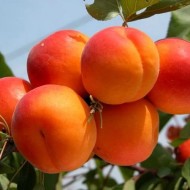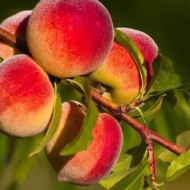Columnar fruit trees: a variety of plants at their summer cottage
Content
The history of the appearance of columnar trees
For the first time, they started talking about columnar trees in 1964. One of the residents of the Canadian province of British Columbia grew Macintosh apple trees on his site. Walking around the garden one day, he noticed a vertically growing, even branch without the usual horizontal shoots, densely covered with beautiful fruits. The Canadian was so struck by the unusual phenomenon that he shared his discovery with breeders.
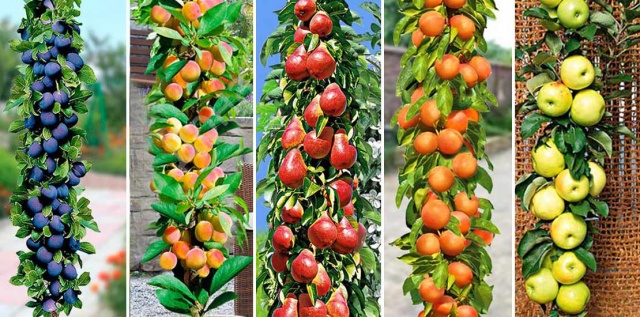
After a long study and numerous experiments in Canada, the first variety of columnar apple was grown - Vazhak. A few years later, the trees were already grown by Europeans, but on the territory of the Russian Federation they appeared only a few years ago.
Video "Secrets of growing columnar pears"
In this video, gardeners talk about the peculiarities of planting and growing columnar pears.
Features of the appearance of plants
Columnar trees are easily distinguished from common fruit crops by their crown shape, which resembles cypress or pyramidal poplar. Its diameter does not exceed 50 cm, and the height of the plant is only 2.5 m. Small lateral shoots with short internodes grow on thick vertical branches, on which ovaries are formed, and then fruits. Due to such an unusual structure, it seems that the fruit sticks to the very trunk of the tree.
Selected varieties have high yields, but for the same reason they bear fruit only for 10–12 years. Seedlings of columnar crops are much thicker and do not have horizontal shoots.
Types and varieties of columnar fruit trees
Starting with the apple tree, breeders have bred many varieties of other columnar fruit trees over half a century. Thus, new types of pears, peaches, apricots, plums, nectarines, and cherries appeared. The hybrids obtained by crossing are distinguished by increased resistance to low temperatures, diseases and pests.
Apple tree
The most popular variety is Currency. The height of the tree is from 1.5 to 2.3 m. Fruits are light yellow, with a red side, weighing 140–250 g. Apples with juicy pulp, sweet, have a long shelf life. Apple is harvested in the third decade of September.
Arbat belongs to dwarf species. The fruits are bright cherry in color, weighing 65–125 g. The apples are juicy, fragrant, with sourness. The crop ripens in August-September, but has a poor keeping quality.
The President is a semi-dwarf variety up to 3 m high. Large apples (140–250 g), squeezed from the poles, light yellow with a pinkish barrel. The pulp is sweet and sour, juicy. The crop can be stored for 1.5 to 4 months. Collection time - early September.
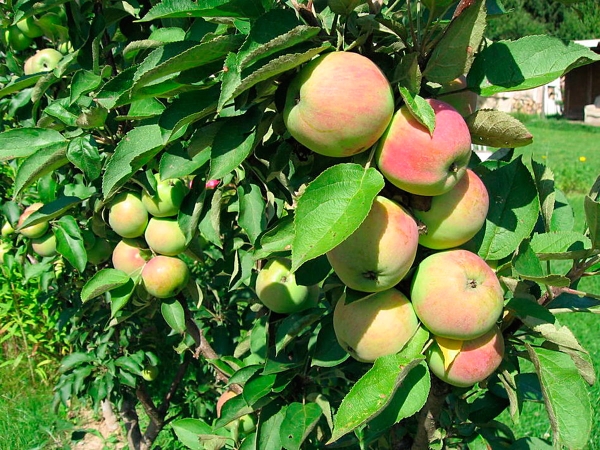
Pear
Dwarf Decora produces fruits, the weight of which ranges from 150 to 200 g.The pears are short-oval, straw-colored, with a burgundy barrel. They have a sweet and sour taste. The crop is harvested at the end of summer. The fruits are stored for only 2 weeks.
The Sapphire variety is distinguished by its large oval-shaped fruits (150-200 g). Pears are yellow-green in color; when fully ripe, they are covered with a reddish blush. Inside are white, juicy, fragrant. They have a sweet and sour taste. Harvested at the end of September, the crop can be stored until December.
Tenderness - a medium-sized variety with large fruits (200-400 g) of green color and a pinkish barrel. The pears are sweet, with a subtle sourness. Harvesting begins at the end of August. You can store pears for no more than 2 weeks.
Plum
Blue suvit variety refers to dwarf species and gives fruits weighing up to 75 g. Plums are dark purple in color, oval. The bone is easily separated from the pulp. The taste is sweet, with a slight sourness. The crop is ready to be harvested at the end of summer.
The fruit of the Imperial variety weighs 55 g. The round fruit is sweet in taste and has a yellow fleshy pulp. The skin is dense, pink-purple in color. The harvest begins in late August.
Honey plum belongs to tall varieties and can grow up to 3-5 m. Fruits are round, bright yellow, very sweet. The pulp is firm, with a hard-to-remove bone. The ripening period is mid-summer.

Apricot
The Zvezdny variety gives round, bright yellow fruits weighing up to 100 g. The fruit inside is fleshy, juicy, and sweet in taste. Ripening period - mid-July.
Dwarf variety Gold with fruits weighing 60–90 g. Apricots are oval, light orange in color, with a red barrel. The pulp is firm, dark orange, with a hard-to-remove bone. The harvest begins at the end of July.
Sayan apricot is a medium-sized plant up to 3 m high. It is distinguished by small sweet-sour fruits of yellow-orange color, weighing 25–35 g.
The Sayansky variety is early ripening, the fruits are ready for harvest at the beginning of summer.
Peach
The Golden Triumph variety is distinguished by its small size (up to 1.5 m) and large fruits (up to 285 g). Pale yellow peaches with a red blush. The pulp is firm, sweet. Harvest time is the first days of July.
Fruits of the Medovy variety have a weight of 175-180 g, yellow with a reddish barrel. They are distinguished by a very sweet taste and easily detachable pits. The harvest ripens in mid-July.
Steinberg is a dwarf variety with oval fruits, yellow-orange in color, with a raspberry blush. The mass of peaches is 150–160 g. The pulp is juicy and sweet in taste. Full ripening period is June.
Nectarine
The undersized Rubis cultivar reaches only 1.2–1.5 m in height. Fruits in large yellow-orange fruits (140–160 g) of a round shape. The sweet fruit has a dense yellow flesh. Harvesting begins at the end of July.
Nectarine Fantasy gives weighty fruits weighing up to 175 g. Ripe round fruits are distinguished by a rich orange color with a burgundy blush. Inside, the fruit is tender, juicy, and tastes sweet. Collection time is August.
Fruits of the Roman variety are round, weighty (150–160 g), light yellow in color with a burgundy barrel. The taste is sweet, slightly sour, very juicy. The bone is easily separated from the pulp. Harvested in mid-August.
Cherries
The most popular variety of columnar cherries is Helena. The height of the tree can reach 3 m. Fruits are rich dark red with burgundy pulp. Their weight reaches 12-14 g. The dense pulp has a sweet taste. The crop is ready for harvest in mid-June.
Sam - medium-sized sweet cherry up to 3 m high bears fruit with sweet burgundy fruits. Their mass is 10–12 g. Inside, they are elastic, reddish. The plant belongs to varieties of early ripening - the crop is harvested in early June.
Little Sylvia belongs to the dwarf varieties. The mass of maroon fruits ranges from 10 to 14 g. Inside, they are red, with pinkish veins, elastic. Cherry ripens at the end of June.

Advantages and disadvantages
Columnar fruit trees have significant advantages over conventional fruit crops:
- compactness;
- bountiful annual harvest;
- unpretentious care;
- high survival rate;
- frost resistance;
- resistance to diseases and parasites.
The disadvantages of breeding dwarf plants include:
- short fruiting period;
- high soil depletion;
- possible curvature of the trunk;
- high cost of planting material.
Landing technology
In order for columnar fruit trees to take root well and give a bountiful harvest, certain agrotechnical planting rules should be adhered to.
Optimal timing
It is best to plant fruit crops in early spring, when the frost has already ended, and the soil has warmed up a little. The soil for spring planting is prepared before winter. Some gardeners allow columnar trees to be planted in the fall. For this, preparation must be carried out in 14 days.
Site selection and soil preparation
Fruit trees feel comfortable in the lighted areas of the garden. It is better to choose a place on a hill, with a low level of groundwater. The soil should be fertile, breathable, loamy or sandy. Before planting, 100 g of phosphorus and potash fertilizers are applied to the ground. The use of compost is allowed.
Correct fit
The peculiarities of columnar crops make it possible to plant trees at a distance of 40–120 cm from each other. The planting hole is dug up to a depth of 60–70 cm and a width equal to the size of the root system. Before planting, a layer of organic fertilizers is poured onto the bottom, and then 5–7 liters of water are poured. After the moisture has been absorbed, the seedlings are planted, sprinkling the rhizomes with earth.
The grafting site should not be buried in the ground, since the tree will not bear fruit.
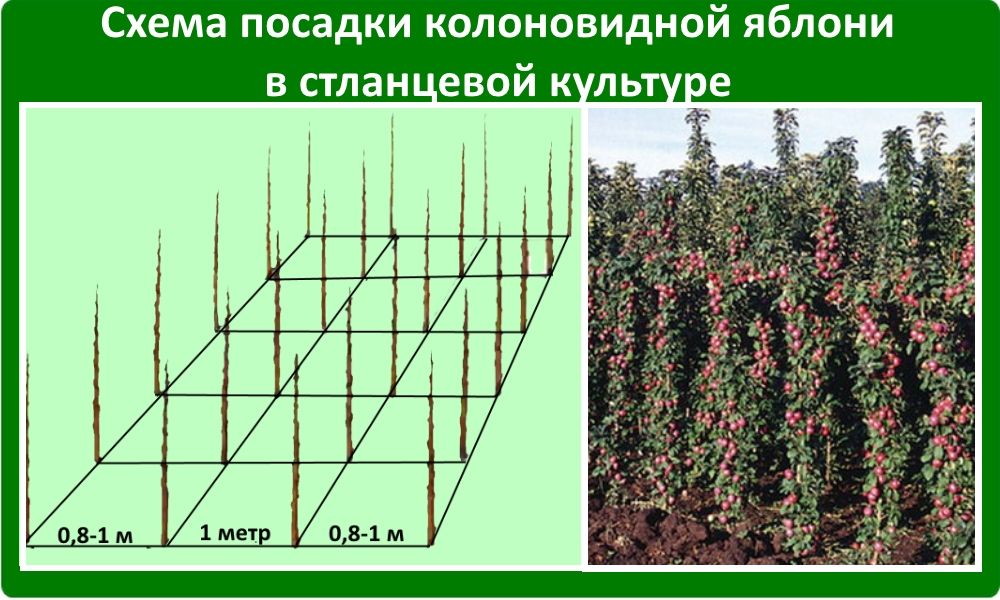
Growing secrets
Despite their unpretentiousness, columnar fruit trees require special, proper care.
Watering and feeding
Selected varieties need abundant watering, especially the first time after planting. Further, the plants are irrigated no more than 2 times a week. In the absence of rainfall for a long time, gardeners recommend moisturizing the green part of the trees, as well as the trunk. Drip irrigation is best suited for columnar crops, since they do not like stagnant moisture.
Hybrid varieties start feeding in the spring. The procedure consists of 3 stages with an interval of 2 weeks. The soil is fertilized with bird droppings, ammonium nitrate or special compounds for fruit trees. Urea can also be added to the soil, which is also suitable for spraying plants. The last feeding is carried out in the second half of August with potassium nitrate.
Pruning
In order to properly form the crown, columnar trees need to be pruned regularly. The main branches release from 2 to 10 short shoots, which are removed twice a season - in spring and early June. Some gardeners recommend a second procedure in the fall, before wintering. Short twigs are pinched off by one third, and the places of the cuts are treated with garden varnish.
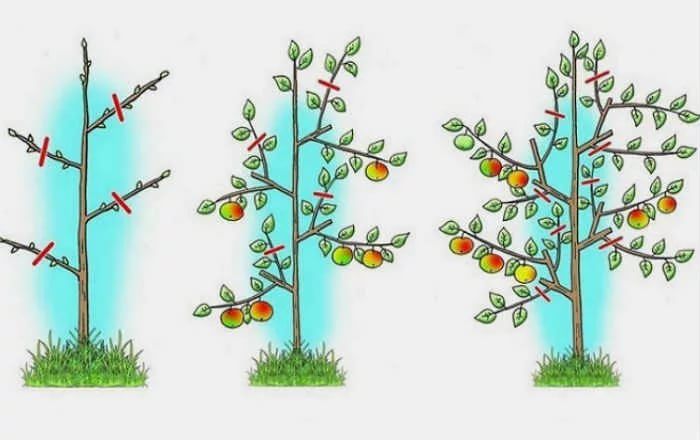
Transfer
The transplant is no different from conventional fruit crops. The plant is dug out, leaving a large clod of earth on the rhizome, and transplanted to a new place. The planting hole is formed in the same way as for the first planting. The procedure can be carried out from the last days of March to the end of April.
Diseases and pests
Although columnar varieties are resistant to diseases and pests, they are also affected by some infections or insects. You can determine the presence of parasites by the appearance of the plant. The foliage withers, dries up, becomes yellow. The main culprits are:
- aphid;
- mole;
- shield;
- mite.
To cope with them will help insecticides, which are sprayed on trees during the formation of ovaries and after flowering.
Fight against fungal diseases with the help of fungicides. Most often, columnar cultures are susceptible to:
- powdery mildew;
- scab;
- fruit rot;
- spotting;
- cytosporosis.
Application in landscape design
Fruit columnar crops are rarely used in landscape design. Conifers are more suitable for decoration. They go well with alpine slides, rocky compositions. They are often planted in parks or public spaces, creating hedges, framing paths and gazebos. Also, designers love deciduous plants (birch, maple, linden). The unusual curvature of the trunk of the selected varieties gives the garden a unique flavor. Columnar trees are often combined with flowers or flower beds.

Knowing the features of columnar crops, you can easily grow original plants in your summer cottage. With minimal maintenance requirements, they produce bountiful crops and bring aesthetics even to a small garden.

